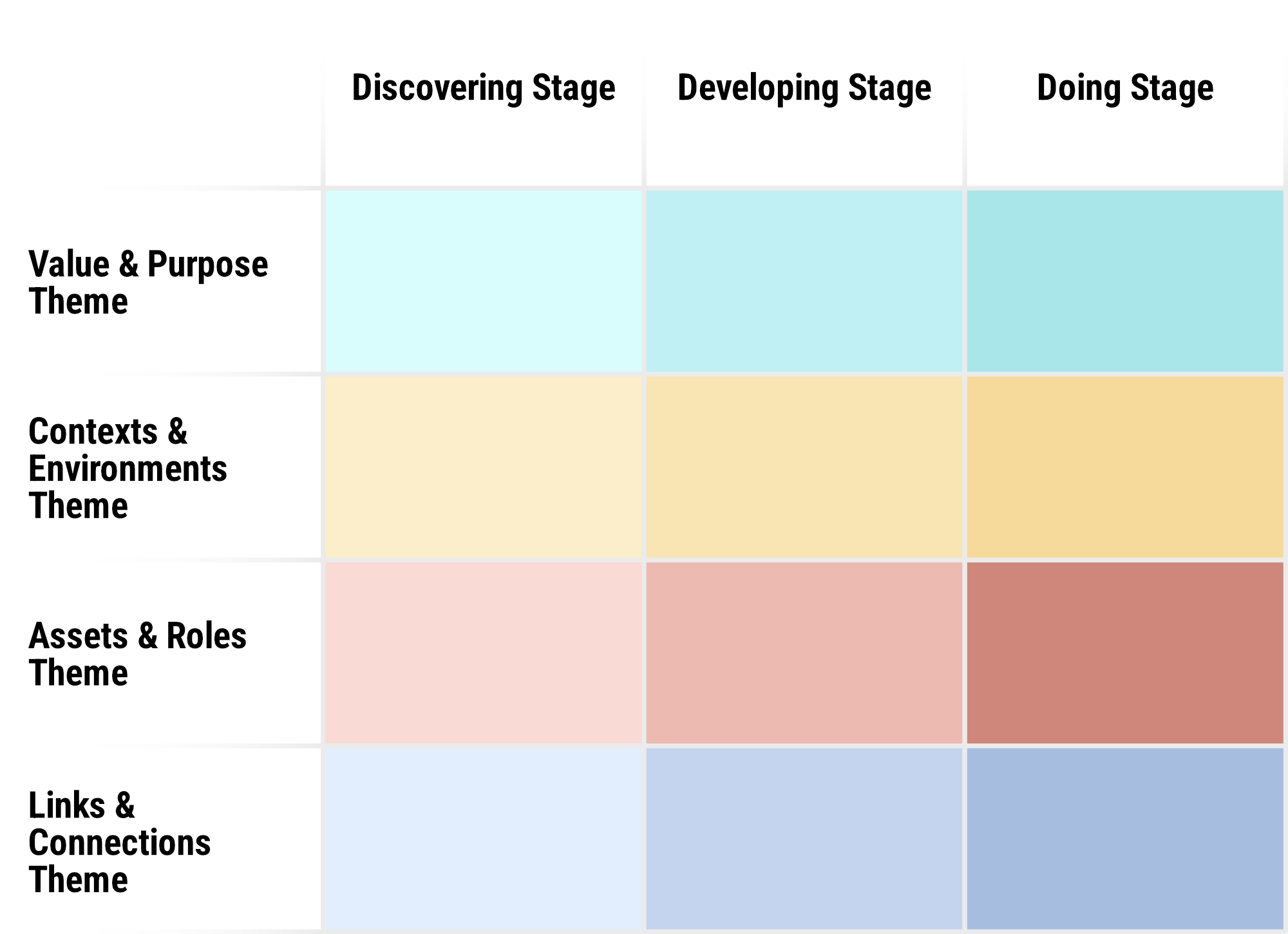Framework for Conversations
Tools for Building Equitable Entrepreneurial Ecosystems
The heart of ecosystem building consists in starting and sustaining the conversations and relationships that set the stage for collaboration and success. In this section you’ll find a framework for having those conversations, outlining the key themes in ecosystem building and the related stages. For each theme and stage there are topics to explore and stages within those topics.
We recommend that you take a moment to consider the themes, stages, and topics that are most relevant to your context, and then identify challenges that you are working on. For each challenge you’ll find considerations, conversation guides, resources and examples, as well as links to the toolkit online community. Please note, this framework is not intended to be used as a linear path–think of it more as a “choose your own adventure” in which you elect the relevant topics, conversation, and sequence that are most beneficial at your institution and context. The same organization may be at the “Discovering” stage for some conversations and at other stages for others.
Themes and Stages Framework Grid for Ecosystem Building
Discovering Stage
Understanding what your ecosystem looks like now. In the Discovering stage, the focus is on gaining a deep understanding of the current state of the entrepreneurial ecosystem. This involves assessing existing strengths, weaknesses, opportunities, and threats to inform future strategies.
Developing Stage
Envisioning how you might strengthen your ecosystem. During the Developing stage, ecosystem builders envision and plan for the enhancement and strengthening of the ecosystem. This includes setting strategic goals, identifying areas for improvement, and formulating strategies to achieve those goal
Doing Stage
Creating and implementing ecosystem activities. The Doing stage involves the active implementation of ecosystem-building activities and initiatives. Ecosystem builders execute their plans, collaborate with stakeholders, and work toward achieving the defined objectives to support entrepreneurship and innovation.
Value & Purpose Theme
The value an ecosystem aims to create and defining who benefits from its endeavors, with a broader emphasis on purpose and societal impact.
Discover Purpose
Delve into the heart of your ecosystem to unearth its fundamental purpose. Your goal is to uncover who stands to gain from a thriving ecosystem and what their needs and aspirations are. By identifying the jobs, pains, and gains of your stakeholders, you lay the groundwork for defining the ecosystem’s intended impact.
Ideate for Value Creation
Brainstorm and strategize with ecosystem partners to unlock the full potential of value creation. You explore innovative ways to address the needs of your beneficiaries and envision how your ecosystem can offer unique solutions, products, or services that resonate with them.
Implement Value-Creating Activities
You and your ecosystem partners roll up your sleeves and bring your value-creating ideas to life. This involves executing concrete actions, whether it’s launching products, services, or initiatives, to deliver tangible benefits to your target beneficiaries.
Contexts & Environments Theme
The external forces, such as culture, policies, and market dynamics, that shape an entrepreneurial ecosystem, and how to adapt and cultivate favorable conditions.
Explore the Ecosystem Landscape
Embark on a journey to comprehend the complex web of cultural, political, policy, geographic, and institutional factors that shape your ecosystem. This knowledge provides the foundation for strategic decision-making.
Cultivate & Scaffold
Work collaboratively with partners to nurture the ecosystem’s supportive contextual factors. It’s about identifying opportunities for collaboration and creating an environment that encourages innovation and entrepreneurship.
Shape & Reshape
Engage with ecosystem partners to influence and adapt environmental factors. This might involve advocating for policy changes, establishing new institutions, or reshaping existing ones to foster a more conducive ecosystem.
Assets & Roles Theme
Identifying and leveraging the critical assets and roles within the ecosystem, including resources, human capital, and the responsibilities of ecosystem participants.
Inventory & Map
Undertake a comprehensive audit of the ecosystem’s assets and roles in this stage. This involves identifying who plays what role, with what resources, and understanding how these roles and assets interconnect. The aim is to create a comprehensive map of the ecosystem’s components.
Assess Alignment & Gaps
Assess how well these components align with the ecosystem’s goals. Identify gaps in resources and capabilities, setting the stage for strategies to leverage existing strengths and address weaknesses.
Put the Ecosystem to Work
Execute on the plans and activities designed to harness the ecosystem’s assets and roles. By putting these elements to work effectively, you maximize the ecosystem’s potential for driving innovation and entrepreneurship.
Links & Connections Theme
The network dynamics and collaborative relationships among ecosystem actors, emphasizing the importance of synergy and effective governance.
Illuminate Interdependence
Focus on revealing the intricate web of relationships and dependencies among assets and roles. This understanding helps you identify the key players and connections that sustain the ecosystem.
Strengthen Ties
Strategize ways to foster new connections and fortify existing ones. Strengthening ties between assets and roles enhances collaboration and knowledge exchange, facilitating the ecosystem’s growth.
Partner & Collaborate
Initiate partnerships and collaborations to harness the synergies among assets and roles. These partnerships can lead to the alignment of resources, expertise, and efforts, creating a more cohesive and thriving ecosystem.
Themes and Stages Framework Grid for Ecosystem Building

Value & Purpose Theme
The value an ecosystem aims to create and defining who benefits from its endeavors, with a broader emphasis on purpose and societal impact.
Discover Purpose
Delve into the heart of your ecosystem to unearth its fundamental purpose. Your goal is to uncover who stands to gain from a thriving ecosystem and what their needs and aspirations are. By identifying the jobs, pains, and gains of your stakeholders, you lay the groundwork for defining the ecosystem’s intended impact.
Ideate for Value Creation
Brainstorm and strategize with ecosystem partners to unlock the full potential of value creation. You explore innovative ways to address the needs of your beneficiaries and envision how your ecosystem can offer unique solutions, products, or services that resonate with them.
Implement Value-Creating Activities
You and your ecosystem partners roll up your sleeves and bring your value-creating ideas to life. This involves executing concrete actions, whether it’s launching products, services, or initiatives, to deliver tangible benefits to your target beneficiaries.
Contexts & Environments Theme
The external forces, such as culture, policies, and market dynamics, that shape an entrepreneurial ecosystem, and how to adapt and cultivate favorable conditions.
Explore the Ecosystem Landscape
Embark on a journey to comprehend the complex web of cultural, political, policy, geographic, and institutional factors that shape your ecosystem. This knowledge provides the foundation for strategic decision-making.
Cultivate & Scaffold
Work collaboratively with partners to nurture the ecosystem’s supportive contextual factors. It’s about identifying opportunities for collaboration and creating an environment that encourages innovation and entrepreneurship.
Shape & Reshape
Engage with ecosystem partners to influence and adapt environmental factors. This might involve advocating for policy changes, establishing new institutions, or reshaping existing ones to foster a more conducive ecosystem.
Assets & Roles Theme
Identifying and leveraging the critical assets and roles within the ecosystem, including resources, human capital, and the responsibilities of ecosystem participants.
Inventory & Map
Undertake a comprehensive audit of the ecosystem’s assets and roles in this stage. This involves identifying who plays what role, with what resources, and understanding how these roles and assets interconnect. The aim is to create a comprehensive map of the ecosystem’s components.
Assess Alignment & Gaps
Assess how well these components align with the ecosystem’s goals. Identify gaps in resources and capabilities, setting the stage for strategies to leverage existing strengths and address weaknesses.
Put the Ecosystem to Work
Execute on the plans and activities designed to harness the ecosystem’s assets and roles. By putting these elements to work effectively, you maximize the ecosystem’s potential for driving innovation and entrepreneurship.
Links & Connections Theme
The network dynamics and collaborative relationships among ecosystem actors, emphasizing the importance of synergy and effective governance.
Illuminate Interdependence
Focus on revealing the intricate web of relationships and dependencies among assets and roles. This understanding helps you identify the key players and connections that sustain the ecosystem.
Strengthen Ties
Strategize ways to foster new connections and fortify existing ones. Strengthening ties between assets and roles enhances collaboration and knowledge exchange, facilitating the ecosystem’s growth.
Partner & Collaborate
Initiate partnerships and collaborations to harness the synergies among assets and roles. These partnerships can lead to the alignment of resources, expertise, and efforts, creating a more cohesive and thriving ecosystem.

